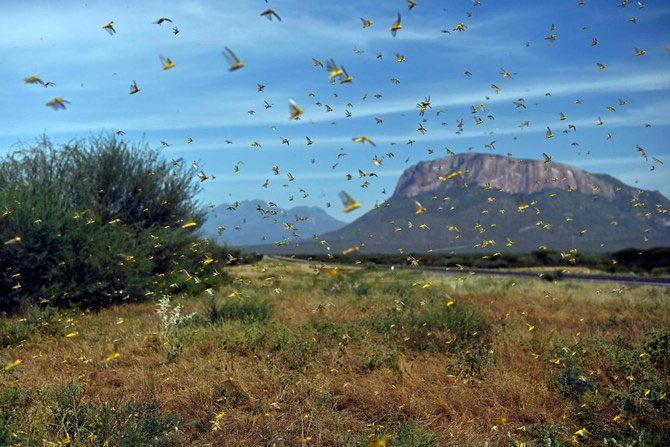Scientists have recently discovered a type of pheromone (a chemical substance secreted by the body that serves as a means of communication between individuals of the same species) in locusts, which helps this species avoid being preyed upon by their own kind in social living.
This discovery paves the way for finding effective methods to control this voracious insect species that threatens the food security of millions across Asia and Africa. The research findings were published in the journal Science on May 4.

A swarm of locusts near Lerata village in Samburu, Kenya. (Photo: AFP/TTXVN).
Bill Hansson, the lead researcher and head of the Evolutionary Neurobiology Department at the Max Planck Institute in Germany, stated that locust behavior is driven not by cooperation among individuals but by the fear of being cannibalized.
In fact, cannibalism is a common phenomenon in the natural world, such as lions killing and eating cubs that are not their own or foxes scavenging on their own kind. For locusts, cannibalism is believed to help maintain ecological balance among them.
Grasshoppers (Locusta migratoria) exhibit various forms and behave very differently from typical grasshoppers. For most of the time, this species lives “solitarily” and feeds relatively little, resembling those grasshoppers that are “shy.” However, when their population density increases and food becomes scarce, they begin to produce hormones that alter their behavior, causing them to gather in swarms and become more aggressive.
According to a 2020 study by Iain Couzin from the Max Planck Institute for Animal Behavior, this process is called the “swarming phase,” and the fear of being cannibalized drives the entire swarm to move in the same direction towards areas with more food. Scientist Hansson explains, “locusts eat their kind from behind.” Therefore, if they stop moving, they risk being preyed upon by others, which leads the research group to believe that almost all animal species have some methods of coping when threatened.
In a series of experiments conducted over four years, Hansson’s research team first identified that the actual rate of cannibalism increased proportionally with the number of locusts living in the same cage. Locusts began to cannibalize each other when their numbers exceeded 50 in the same enclosure. Next, they compared the odors emitted by solitary locusts and those living in swarms, finding 17 distinctive substances that were only secreted when they lived in groups. Among these was phenylacetonitrile (PAN), which acts as a repellent against their own kind. PAN is involved in the synthesis of a potent toxin called hydrogen cyanide, which locusts sometimes secrete; thus, its release appears to serve as a signal for others to back off.
To confirm this new discovery, scientists used the CRISPR method to edit the locust genes, preventing them from producing PAN, thus making them more susceptible to cannibalism. Alongside this, the scientists tested dozens of olfactory receptors (which are responsible for scent detection) in locusts and found a receptor that was very sensitive to PAN. When they edited the genes so that locusts no longer produced this receptor, they tended to cannibalize each other more.
The research team evaluated this new discovery as shedding light on the “complex balance” between the mechanisms that cause locusts to swarm together instead of competing with each other. Consequently, future locust control methods may leverage technologies that create a delicate balance favoring more competition. The ultimate goal is not to eliminate the migratory locust species but to help reduce the scale of locust swarms, directing them towards areas where human agricultural activities are absent.




















































